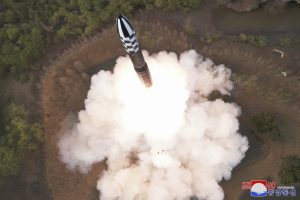North Korea confirmed that the missile tested on Thursday was the Hwasong-18, a new type of intercontinental ballistic missile (ICBM).
“A new-type ICBM, Hwasongpho-18, which will fulfill its mission of an important war deterrent as the future core pivotal means of the strategic force of the DPRK, was test-fired,” Korean Central News Agency (KCNA), one of the North’s main state-controlled media, reported on Friday. (DPRK is an acronym of the North’s official name: Democratic People’s Republic of Korea)
According to KCNA, North Korea tested a new solid-fuel ICBM, which was first unveiled during the military parade in February.
“The aim of the test-fire was to confirm the performance of the high-thrust solid-fuel engines for multi-stage missiles and the reliability of the stage-jettisoning technology and various functional control systems and to estimate the military feasibility of the new strategic weapon system,” KCNA said.
In December 2022, North Korea said it conducted a first test of a “high-thrust solid-fuel motor” at the Sohae Satellite Launching Ground. Four months later, it conducted a test of a solid-fuel ICBM, implying that the new type of missile has been thoroughly developed as planned.
Guiding the missile while accompanied by his wife, Ri Sol Ju, and his “beloved daughter,” Kim Ju Ae, Kim Jong Un, the supreme leader of North Korea, said “the development of the new-type ICBM Hwasongpho-18 will extensively reform the strategic deterrence components of the DPRK.” According to the KCNA report, he also said his party and the government “would make the enemy … experience a clearer security crisis, and constantly strike extreme uneasiness and horror into them by taking fatal and offensive counter-actions until they abandon their senseless thinking and reckless acts, thus making them feel regret and despair for their wrong choice by surely exposing them to an irresistible threat.”
Following KCNA’s release of details on the Hwasong-18 ICBM test, the South Korean military downplayed the missile test, saying the technologies North Korea claimed to have tested are the usual technologies needed for developing ballistic missiles. Calling the Hwasong-18 missile test a mid-level stage for developing a solid-fuel ICBM, Seoul also added that the North would need to take more time and effort to fulfill all requirements for the development of a solid-fuel ICBM.
Along with the devaluation, the South Korean military soothed concerns over the possibility of the North penetrating its “three-axis” system, South Korea’s strategy for handling a future nuclear conflict scenario with the North, saying its defense system has developed following the growing threats posed by North Korea.
Despite Seoul’s emphasis on its strong missile defense capabilities, the noteworthy part is that North Korea seems to have made substantive progress toward developing a solid-fuel intercontinental ballistic missile – which could be considered as a direct threat to the security of the United States. As Pyongyang has demonstrated its firm willingness and capabilities to show off new missile programs continuously, Washington’s cards for future nuclear talks will likely be limited if it does not devise a proactive and forward-looking policy on North Korea.
Thursday’s Hwasong-18 ICBM launch is another reminder that the current arms race and build-up are not the most effective means to construct permanent peace in the region.

































